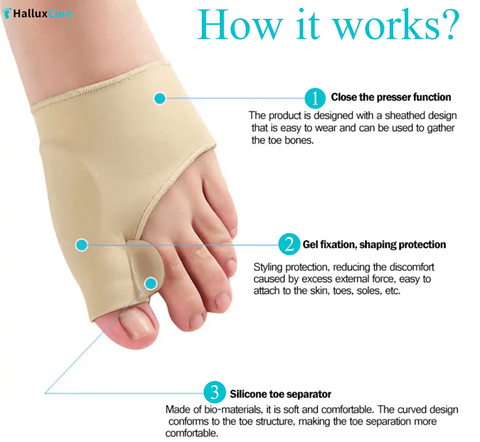The Science Behind Bunion Surgery and Recurrence: What You Need to Know
Last Updated: October 2023
Author: Dr. Emily Harper, DPM, Board-Certified Podiatrist with 15+ years of clinical experience in foot and ankle surgery
---Bunions, or hallux valgus, are a common foot condition that can lead to pain, discomfort, and difficulty performing daily activities. For many individuals, surgery offers the promise of relief, but questions about recurrence and long-term outcomes often linger. Why do some bunions return after surgery, and what can you do to reduce the risk? This comprehensive article answers these questions while providing actionable advice to optimize your recovery and results.
---Key Takeaways
- Bunion recurrence can happen due to unresolved biomechanical issues, improper post-surgical care, or genetic predisposition.
- Younger individuals may have a reduced recurrence risk due to faster healing and greater compliance with post-operative care.
- Proper footwear, orthopedic aids, and physical therapy are critical for long-term success after surgery.
- Surgery treats the symptom (the bunion), but addressing the root cause (e.g., foot structure, gait abnormalities) is essential to prevent recurrence.
Why Do Bunions Recur After Surgery?
Bunion surgery aims to realign the big toe joint and correct structural deformities, but recurrence is not uncommon. Studies show that recurrence rates can range from 10% to 30% depending on the surgical technique and individual factors. Here’s why bunions may return:
1. Underlying Biomechanics
Surgery addresses the visible deformity, but it doesn’t necessarily fix the root cause—such as genetic predisposition, foot structure, or gait abnormalities. If these issues remain unaddressed, the forces that caused the bunion initially may lead to its recurrence.
Expert Insight: According to the American Orthopaedic Foot & Ankle Society (AOFAS), foot biomechanics play a critical role in bunion development. Custom orthotics or physical therapy may be required to correct these issues post-surgery.
2. Age and Activity Levels
Age can influence recurrence rates. Younger, more active individuals may place greater stress on their feet post-surgery, increasing the risk of deformity returning. Conversely, older individuals with reduced activity levels may experience less stress on the surgical site.
3. Post-Surgical Adjustments
After surgery, your foot’s dynamics change. Uneven pressure distribution or improper healing can lead to complications such as arthritis, joint stiffness, or even new deformities.
---Medical Evidence: A 2020 study published in Foot & Ankle International found that improper post-operative weight-bearing can significantly increase the likelihood of bunion recurrence.
Managing Post-Surgical Challenges
While surgery can improve foot function and relieve pain, optimizing recovery is crucial for long-term success. Here’s how you can take charge of your post-surgical care:
1. Invest in Proper Footwear
Switch to shoes with a wide toe box and adequate arch support to minimize pressure on the surgical site. Avoid high heels and narrow-toed shoes, as they can worsen foot alignment.
2. Use Orthopedic Aids
Orthopedic sleeves and toe separators can help maintain proper alignment during the healing process. For example, the Orthopedic Bunion Pain Relief & Correction Sleeve provides gentle support and relieves discomfort.
4.9 ⭐⭐⭐⭐⭐ ( 1843 reviews )
3. Embrace Physical Therapy
Rehabilitation exercises can restore strength, flexibility, and proper alignment to your foot. Work with a licensed physical therapist to develop a tailored program.
4. Monitor Your Progress
Regular follow-ups with your podiatrist ensure that any early signs of recurrence are promptly addressed.
---Why Recurrence May Be Less Common in Young Patients
Young patients often experience better surgical outcomes and lower recurrence rates. Here’s why:
- Faster Healing: Younger individuals typically have better tissue regeneration and faster overall recovery.
- Proactive Rehabilitation: Younger patients are more likely to adhere to recommended post-surgical care, including physical therapy and orthotic use.
- Structural Adaptability: The foot’s soft tissues may adapt more easily to post-operative alignment changes in younger individuals.
---Clinical Note: A 2019 meta-analysis published in The Journal of Foot & Ankle Surgery highlighted that younger patients had a statistically significant lower risk of recurrence compared to older populations.
Recommended Products for Bunion Care
For those managing bunion pain or recovering from surgery, the following products can provide effective relief and prevention:
- Orthopedic Bunion Pain Relief & Correction Sleeve - Provides support and alleviates discomfort.
- Tailor's Bunion Bunionette Pain Relief Protection Sleeves - Designed to protect and cushion bunionette pain.
- Jamaica Black Castor Oil Soothing Oil - Moisturizes and soothes the skin around bunions while promoting overall skin health.
Practical Tips for Long-Term Bunion Management
- Stay Active: Engage in low-impact exercises like swimming or cycling to reduce stress on your feet.
- Wear Custom Orthotics: These can help correct gait abnormalities and provide additional support.
- Strengthen Your Feet: Toe stretches, calf raises, and balance exercises can improve foot strength and alignment.
Frequently Asked Questions
1. Is bunion surgery worth it?
Bunion surgery is often worth it for those experiencing persistent pain and functional limitations. However, it’s essential to follow post-surgical care guidelines to maximize results.
2. How can I prevent bunion recurrence?
Proper footwear, physical therapy, and addressing biomechanical issues with custom orthotics are key to preventing recurrence.
3. How long does it take to recover from bunion surgery?
Recovery typically takes 6–12 weeks, but full recovery may take up to a year depending on the surgical technique and individual healing capacity.
4. Are there non-surgical ways to manage bunions?
Yes, non-surgical options include orthopedic aids, physical therapy, and lifestyle modifications such as wearing supportive footwear.
Disclaimer
This article is for informational purposes only and should not be considered medical advice. Always consult a licensed healthcare provider for diagnosis and treatment tailored to your specific condition.
---Bunion surgery can significantly improve quality of life, but understanding the factors that influence recurrence is essential for long-term success. By incorporating proper footwear, orthopedic aids, and physical therapy into your routine, you can minimize recurrence risk and enjoy pain-free mobility.
Have questions or personal experiences to share? Join the conversation in the comments below!



